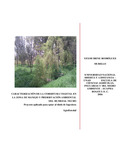Mostrar el registro sencillo del ítem
Caracterización de la cobertura vegetal en la zona de manejo y preservación ambiental del humedal Techo.
| dc.contributor.advisor | Díaz Santamaría, William Ricardo | |
| dc.coverage.spatial | cead_-_josé_celestino_mutis | spa |
| dc.creator | Rodríguez Murillo, Yexmi Irene | |
| dc.date.accessioned | 2017-06-24T00:03:15Z | |
| dc.date.available | 2017-06-24T00:03:15Z | |
| dc.date.created | 2016-11-15 | |
| dc.identifier.uri | https://repository.unad.edu.co/handle/10596/12384 | |
| dc.description.abstract | Los humedales son ecosistemas que conservan, distribuyen y crean el ambiente adecuado para la conservación de agua, fauna y flora en la sabana de Bogotá. El humedal de Techo es uno de los ecosistemas más intervenidos por la afectación antrópica en la ciudad. Por ello, se realizó un estudio florístico y estructural en los tres sectores del humedal (Norte, sur y occidental), en parcelas de 1m x 10m y 8m x 10 m a las estructuras arbóreas y arbustivas, y de 2m x 2m para las herbáceas. Se encontró un total de 548 individuos, distribuidos en 20 familias, 28 géneros y 30 especies. Las familias con mayor riqueza en número de género fueron la Solanaceae (4), la Myrtaceae (3), y la Rosaceae (2), Asteraceae (2) y Leguminosae (2). Los géneros con mayor riqueza de especies fueron Salix (2), Ficus (2) y Acacia (2). El IVI fue en el sector norte y sur para la especie Acacia melanoxylon R. Br. Para el sector occidental fue Ricinus communis L. Los tres sectores se presentaron una diversidad muy baja y una muy alta dominancia. El mayor porcentaje de cobertura por estratos evidencio el predominio del estrato arbóreo en los sectores norte y sur y el arbustivo en el occidental. | spa |
| dc.format | spa | |
| dc.format.mimetype | application/pdf | spa |
| dc.language.iso | spa | spa |
| dc.publisher | Universidad Nacional Abierta y a Distancia UNAD | spa |
| dc.title | Caracterización de la cobertura vegetal en la zona de manejo y preservación ambiental del humedal Techo. | spa |
| dc.type | Proyecto aplicado | spa |
| dc.subject.keywords | Ecosistema | spa |
| dc.subject.keywords | Especies herbáceas | spa |
| dc.subject.keywords | Humedales | spa |
| dc.subject.keywords | Preservación Ambiental | spa |
| dc.subject.keywords | Vegetación | spa |
| dc.description.abstractenglish | Wetlands are ecosystems that preserve, distribute and create the right environment for water conservation and wildlife in the savannah of Bogota. Ceiling wetland ecosystems is one of the most affected by human disturbances in the city. Therefore, a floristic and structural study was conducted in the three sectors of the wetland (North, South and West), on plots of 1m x 10m and 8m x 10 m to the tree and shrub structures and 2m x 2m for herbaceous. A total of 548 individuals, distributed in 20 families, 28 genera and 30 species were found. Families with more VI wealth in gender number were Solanaceae (4), the Myrtaceae (3), and the Rosaceae (2), Asteraceae (2) and Leguminosae (2). The genera with highest species richness were Salix (2), Ficus (2) and Acacia (2). The IVI was in northern and southern sector for the species Acacia melanoxylon R. Br. For the western sector was Ricinus communis L. All three sectors a very low diversity and high dominance was presented. The highest percentage of coverage strata evidenced the predominance of arboreal stratum in the northern and southern sectors and the bush in the Western. | spa |
| dc.subject.category | Ingeniería Agroforestal | spa |
| dc.rights.accesRights | info:eu-repo/semantics/openAccess | spa |
| dc.rights.acceso | Abierto (Texto Completo) | spa |
Ficheros en el ítem
Este ítem aparece en la(s) siguiente(s) colección(ones)
-
Ingeniería Agroforestal [234]















